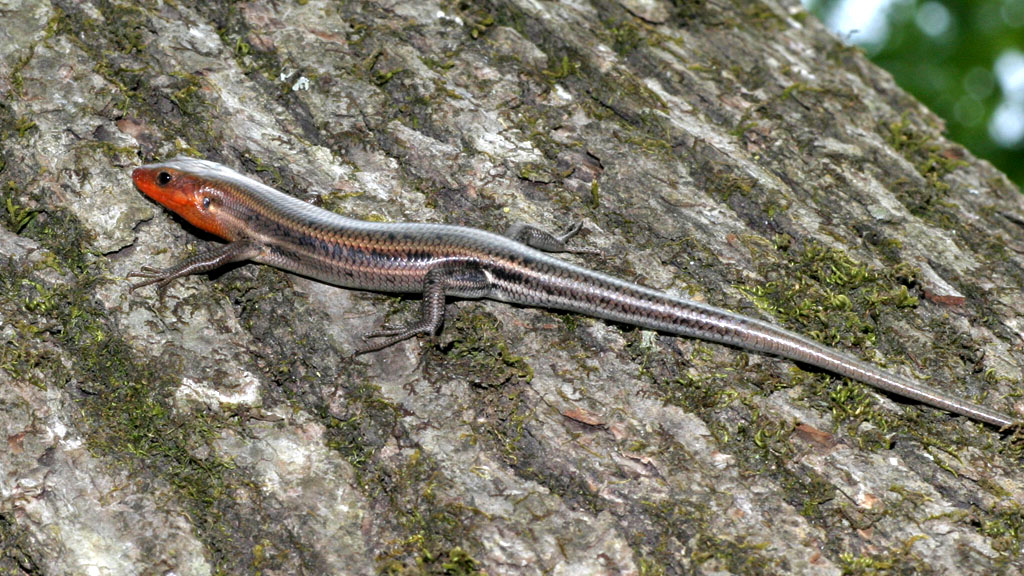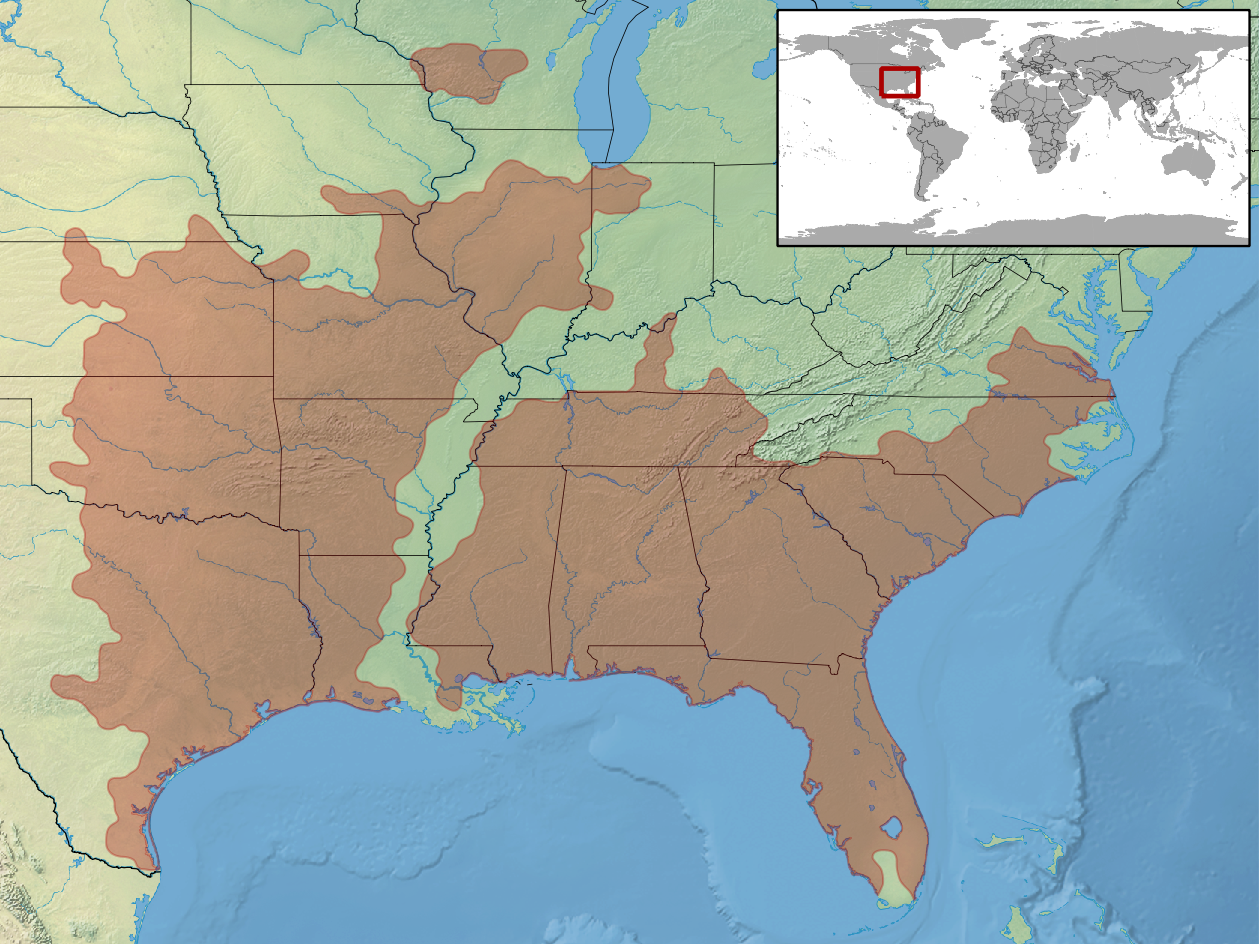There are 6 lizard species which can be found in Indiana, so how do you know what lizard you have in your yard or that you saw on your walk?
Are you looking for information on what lizards you can expect to find in and around Indiana? Continue reading for detailed information to identify the six lizards with ease.
1. Common Five-lined Skink
Scientific name: Plestiodon fasciatus.
Common name: (American) five-lined skink, blue-tailed skink (for juveniles) and red-headed skink (for adults), eastern red-headed skink.
The common five-lined skink (Plestiodon fasciatus) grows up to 8.5 inches (21.5cm). They are large lizards that have very streamlined bodies and short legs.

They tend to be brown, black, or gray in color with five white to yellow stripes, two on either side and one down the center of the back. Juveniles are striking in color with bright blue tails, which fade as they age.
Males often lose their stripes, developing orange or red color on their heads.

The common five-lined skink can be found throughout South Carolina and Georgia. You may see them in trees or on the ground.
They are common in wooded areas with fallen trees and stumps offering excellent hiding place, they also enjoy moist environments and can be found in river forest areas.
While you may see one of these skinks out in the open, they are usually found under bark or logs. They will run for the nearest log or tree when pursued, making it harder to catch them.
They will break off their tail if restrained, which can distract the predator, giving the lizard a chance to escape.
2. Six-lined Racerunner

Scientific name: Aspidoscelis sexlineatus.
Common name: six-lined racerunner.
The six-lined racerunner grows up to 24 centimeters or 9.5 inches.
It is the only lizard in the area that has six light yellow to white stripes that run down the back.
They are exceptionally fast and therefore easily identified.
This is a common lizard found in South Carolina and Georgia, though it won’t be found in the mountainous areas.
They enjoy a hot open area, such as sand dunes, woodland edges, and fields. They prefer being on the ground and seldom will be found in trees.
These fast lizards are active and appreciate the heat, they are alert during the day taking refuge in burrows at night or when faced with a predator.
You will not find the Six-lined Racerunner in a moist or shady habitat, such as river swamps or thick forests.
3. Eastern Fence Lizard

Scientific name: Sceloporus undulatus.
Common name: eastern fence lizard, prairie lizard, fence swift, gray lizard, northern fence lizard, pine lizard.
The eastern fence lizard grows up to 7.25 inches (18.5 cm). They are a member of the spiny lizard family and are native to South Carolina and Georgia. They are gray in color but can range from brown to black.
The female may have black horizontal patterns on her back. During the breeding season, males can be identified for their bright blue patterns on their underside and chin.
These lizards can be found along the coast or in the mountains. They are seldom found far from trees. They do enjoy dry open forest areas with an abundance of stumps and logs to provide hiding spaces from predators.
These are one of the most tree-dwelling lizards, though they can be found on the ground. They will head to the nearest tree if you approach it.
4. Broad-headed Skink

Scientific name: Plestiodon laticeps.
Common name: broad-headed skink, broadhead skink.
The broad-headed skink can grow up to 33 centimeters (13 inches) and are the largest skink in the southeast, except for glass lizards.
They have streamlined bodies with short legs and gray, brown, or black bodies with five white to yellow stripes, which are two on either side and one that runs all the way down the center of the back.
As these lizards mature, they fade to gray or brown with males having orange heads with very powerful jaws. Juveniles have bright blue tails.

These lizards can be seen in trees or on the ground. The larger males tend to prefer tree-dwelling, where they sun themselves on exposed branches.
They will run to the nearest tree if you pursue them and they will break off their tail, which can make it very hard to catch them.
5. Slender Glass Lizard

Scientific name: Ophisaurus attenuatus.
Common name: slender glass lizard.
The slender glass lizards is a long, legless, and very slender lizard that can grow up to 42 inches, that’s 107 centimeters in length.
It is brown to yellow in color with dark marketings just below its lateral groove. They often have a dark stripe, which runs down the center of their backs.

These lizards prefer drier habitats, often found in sandy areas in the Coastal Plain. They can be found beneath boards and debris.
They will break off part of the tail, which makes up more than half the body length, when trying to escape. The tail continues to wriggle, while the lizard escapes.
6. Little Brown Skink

Scientific name: Scincella lateralis.
Common name: Little brown skink, ground skink.
The little brown skink can be easily distinguished from the other lizards due to its small size and its very small front and back limbs.
They are tan, brown, or gray in color with a lateral stripe on either side which is black or brown bordered with a yellow-tan stripe that starts behind the eye.

These small skinks can be found throughout North America where they are most active in the morning and late afternoons.
The little brown skink is a small lizard that only grows two and a quarter inches with a tail that is as long as the body.
They can be found in leaf litter on the ground where they dart around preying on insects. They will dive below the leaves if you approach them.
Further Reading:
I saw a broad-headed skink juvenile on my porch step. Watched it with fascination. Moving from AZ, it’s awesome to see 👀 a lizard!
Had a lizard run up my pant leg and under my shirt, it freaked me out. I have been an Indiana resident for 67 years and until today thought they were only native to warmer climates.